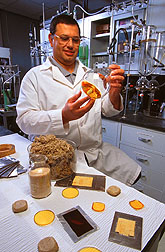This page has been archived and is being provided for reference purposes only. The page is no longer being updated, and therefore, links on the page may be invalid.
|
|
New Liquid Epoxies Created from Cane SugarBy Jan SuszkiwJune 10, 1999 WASHINGTON, June 10--Sugar (sucrose) extracted from sugarcane juice is the main ingredient in new liquid epoxies that can bind wood, metal, glass, concrete and other materials, U.S. Department of Agriculture scientists and collaborators report. The advance may open a new industrial outlet for the sweetener in the form of base coats, primers or adhesives for composite materials like particle boarding or boat hulls. “It’s an example of science finding a surprising new use for a common, everyday agricultural commodity,” said Floyd P. Horn, administrator for the Agricultural Research Service, the USDA agency carrying out the project. More than three million tons of American cane sugar is produced annually, but less than 2 percent is used for non-food purposes, such as fermentation. As a food product, cane sugar has to compete with artificial and low-calorie sweeteners. What sucrose offers that the other sweeteners do not is an abundant, chemically pure source of raw material for creating epoxies that can bind with such diverse materials as wood or plastic, says lead scientist and chemist Navzer D. Sachinvala, at the ARS’ Southern Regional Research Center in New Orleans. “Once these epoxies set, they become clear glassy or rubbery materials, depending on the type used,” Sachinvala says. It’s too soon to say how the new epoxies will fare in a market dominated by petroleum- based products. But Sachinvala cites a few selling points, notably the sucrose epoxies’ lack of ingredients like Bisphenal-A, a component of petroleum-based products. Controversy surrounds the chemical because of its alleged role in disrupting the reproductive system of mice and possibly humans. Other sucrose epoxy benefits include an ability to cure or harden in conditions from below room temperature to 150 degrees Celsius. Lab tests indicate the epoxies are also capable of remaining stable under direct exposure to sunlight and saltwater, Sachinvala reports. Results from studies published in the Journal of Polymer Science also indicate bonding strengths comparable to those of the petroleum product diglycidyl ether of Bisphenal-A, or DGEBA. One of the sucrose epoxies tested, called a crotyl monomer, outperformed the DGEBA product by 30 percent. Sachinvala began exploring cane sugar’s industrial potential in 1988, first as a Case Western Reserve University graduate student, and later as a scientist at Hawaii’s Agricultural Research Center (HARC) in Oahu. In 1996, he joined ARS’ New Orleans center. There, along with HARC scientists Othman Hamed and David Winsor, Sachinvala perfected an epoxidation process that employs reagents like oxygenated vinegar to change sucrose’s molecular structure and chemical properties. Negotiations with an industrial partner are underway to produce large amounts of the sucrose epoxies so commercial criteria like price and performance can be determined and compared to existing materials. A more detailed article appears in the June issue of Agricultural Research, ARS’ monthly publication and on the web at: /is/AR/archive/jun99/epox0699.htm Scientific contact: Navzer D. Sachinvala, ARS Southern Regional Research Center, New Orleans, La., phone (504) 286-4324, fax (504) 286-4271, nozar@commserver.srrc.usda.gov. |

